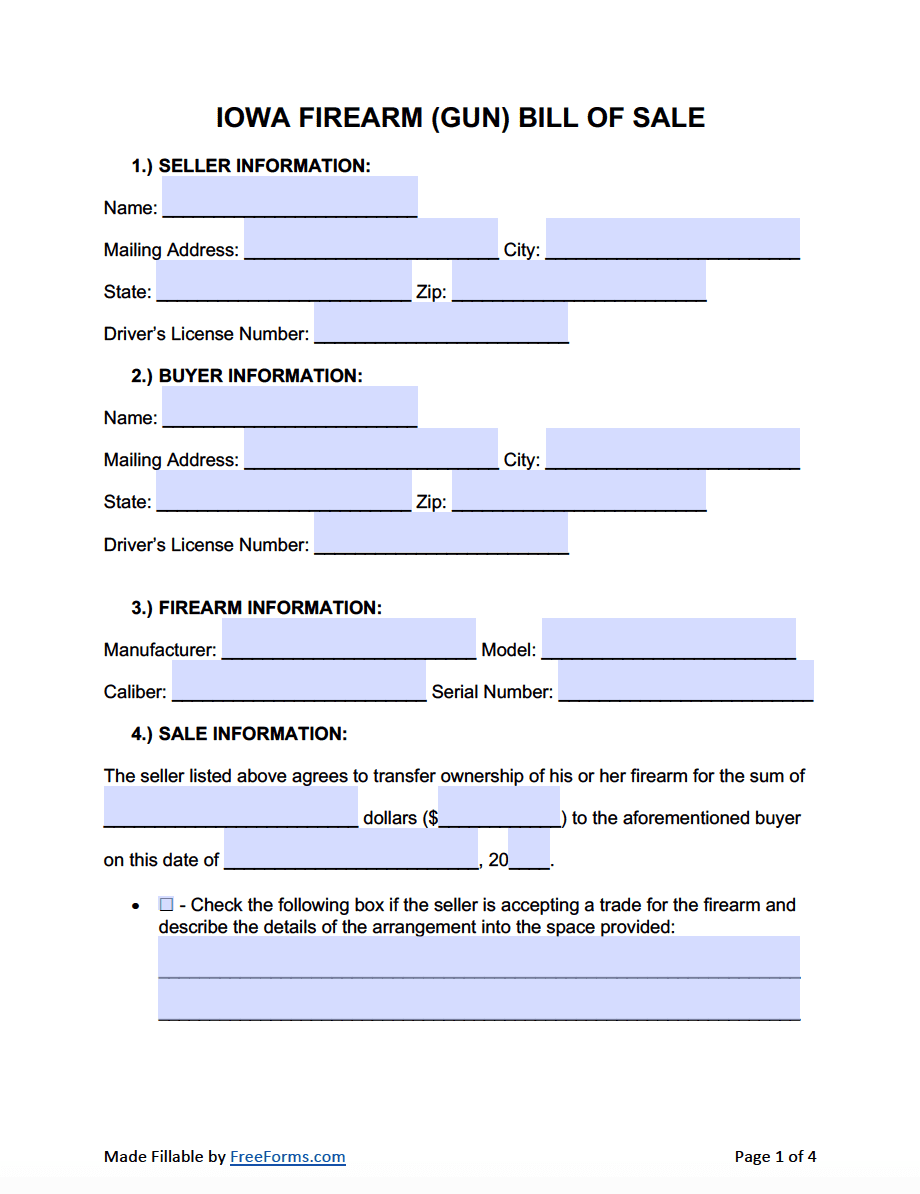The Iowa firearm (gun) bill of sale form is performed in the event of a private sale between two compliant individuals pertaining to property that is classified (by the state) as a firearm/gun. Both sides of the transaction are responsible for filling out the agreement with accurate information concerning the exchange. To generate a more concrete document, involved parties are urged to sign the form while under the observance of a notary public, therefore, allowing the public official to provide their endorsement. (Any sale involving a handgun requires the buyer to present a state-sanctioned permit to purchase, violating this law could result in a penalty.)
How to Register a Gun
No political subdivision within the state of Iowa may enact a law calling for citizens to register their firearms (in correspondence with Iowa Code § 724.28). That being said, there are certain instances where residents are required to obtain special licensing and permits to be in accordance with the law. A permit to purchase is required to buy and own a pistol/revolver (subject to Iowa Code § 724.15), long guns do not require a permit. Also, individuals looking to acquire the right to carry a concealed handgun must first gain specialized weapons permit to do so.
How to Obtain a Permit to Purchase a Handgun
The process to procure a Permit to Acquire varies from county to county. It is suggested that Iowa residents (who are 21 years of age or older and interested in possessing a firearm) contact their local sheriff’s office to inquire about how the licensing procedure operates. Some actions/requirements expected from you may include:
- The completion of an Application for Iowa Permit to Acquire a Pistol or Revolver (some counties will have you fill this out through an online service).
- Have an Iowa government-issued form of identification containing a photograph (driver’s license or state ID).
- Understand that by applying, you will be subject to a NICS background check.
- Be prepared to supply your contact info for the department to inform you of approval or denial. Details such as your:
- Email Address
- & Telephone Number
- Payment to compensate for the necessary application costs.
The permit (if approved) will typically remain valid for five years, after which, the holder will have to renew.
How to Obtain a Concealed Carry Permit
Have you decided that you would like to achieve the freedom to legally carry an open or concealed weapon? If so, you must first put forth a request to your county’s sheriff’s department. Get in touch with the administrative office to attain information on the specific demands required by that particular agency. Here are some of the basic requirements that you should anticipate:
- Review Iowa Code § 724.8 to verify that you are eligible to receive the permit.
- Submit an Application for Iowa Permit to Carry Weapons to your local department in charge of issuing permits (the following counties request that applications be completed through their online system; Dubuque, Scott, Polk, Black Hawk, and Dallas County).
- Be able to provide your personal contact details to ensure that the processing center can reach you by phone or email.
- Have on hand your driver’s license or non-operator ID that has been furnished to you by the state.
- Be aware that the local authorities reserve the right to perform a criminal background check on all individuals applying for a permit.
- Show documentation proving that you have completed a firearms course conducted by a certified NRA instructor (military members may simply provide a copy of their DD-214 Form if it claims that they were honorably discharged).
- Enquire with your local authorities on what type of payment methods are acceptable to cover the cost of applying.
Once your application has been processed, the issuing agency will send you an email or text notifying you that you have either been approved or rejected. If rejected, you may be eligible to receive a refund. Permits remain active for a span of 5-years, apply for renewal at least 30 days before or after it expires.
How to Write
Step 1 – Download in Adobe PDF.
Step 2 – Participant Contact Information – The bill of sale requires that the parties carrying out the agreement divulge the following:
Seller:
- Name
- Mailing Address
- City
- State
- Zip
- Driver’s License Number
Buyer:
- Name
- Mailing Address
- City
- State
- Zip
- Driver’s License Number
Step 3 – Firearm Specifics – It is imperative that you list the following requested features regarding the gun’s description to ensure that it is appropriately identified:
- Manufacturer
- Model
- Caliber
- Serial Number
Step 3 – Sale/Purchase/Trade – Once the seller and buyer have concluded on the terms of the transaction, they must supply the custom facts within the appropriate spaces, which include:
- Written Price (in dollars) of the Purchase & Sale
- Numerical Price (in dollars) of the Purchase & Sale
- The current date on which the document is being executed (month, day, year).
- Only if Trade: Mark the necessary box and insert a condensed synopsis of how the trading will occur.
Step 4 – Disclosure Section – Participants will each be presented with a disclosure statement geared towards their side of the transaction. If they comply with the proclamations displayed, the concluding measure requires them to sign on the indicated line beneath.
Step 5 – Signing the Form – The last demand is what solidifies the document’s validity. Users are instructed to provide the following:
- Seller Signature and Printed Name
- Buyer Signature and Printed Name
- Witness #1 Signature and Printed Name
- Witness #2 Signature and Printed Name
It is recommended that a notary public survey all signatures and complete the sections dedicated to notarization.



0 comments
Comments are closed.